The Featured Creatures collection provides in-depth profiles of insects, nematodes, arachnids and other organisms relevant to Florida. These profiles are intended for the use of interested laypersons with some knowledge of biology as well as academic audiences.
Introduction
The Chrysopidae are one of the largest and economically most important families of the order Neuroptera. There are about 1,300 currently recognized species included in about 87 genera and three subfamilies (Brooks and Bernard 1990) in the world. In Florida, there are 22 species in nine genera, all placed in the subfamily Chrysopinae (Penny et al. 1997). The larvae are voracious predators of small, comparatively soft-bodied arthropods, such as aphids, scale insects, whiteflies, thrips, insect eggs, and other prey (Muma 1959; Canard et al. 1984). For this reason, they are used widely in biological control. The adults (Figures. 1–4) are usually predacious, but a few species only feed on pollen.
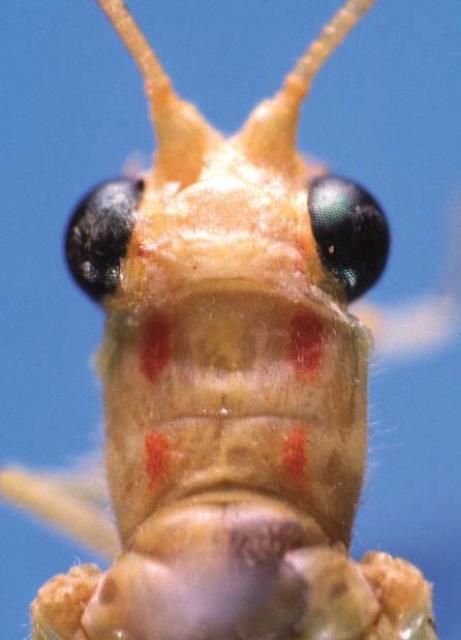
Credit: Jeffrey Lotz, Florida Department of Agriculture and Consumer Services, Division of Plant Industry
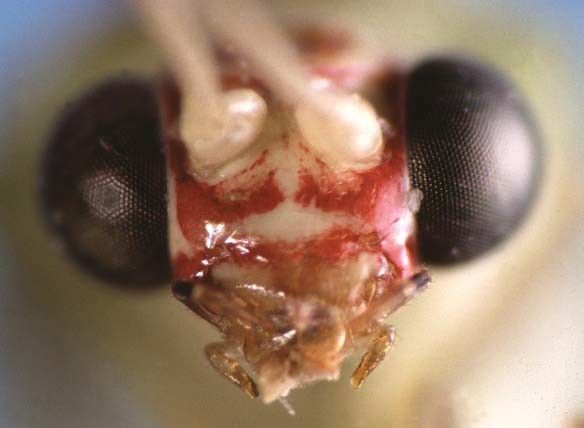
Credit: Jeffrey Lotz, Florida Department of Agriculture and Consumer Services, Division of Plant Industry
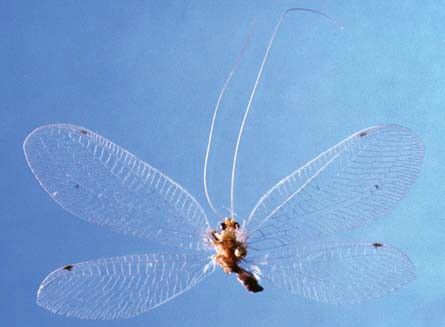
Credit: Jeffrey Lotz, Florida Department of Agriculture and Consumer Services, Division of Plant Industry.
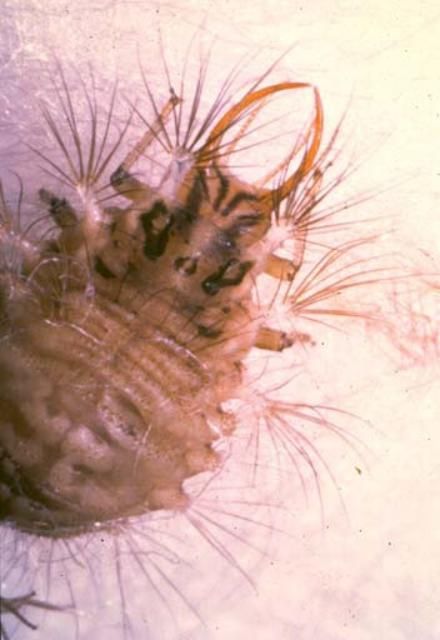
Credit: Jeffrey Lotz, Florida Department of Agriculture and Consumer Services, Division of Plant Industry.
Identification
The members of this family are usually greenish in color when alive, but often turn yellowish after death. Certain groups are brownish in color. Nearly all members of this family have a tympanic organ located ventrally on the base of the radial vein (except species of Nothochrysinae), which is unique among insects. Adult green lacewings have biting mouthparts: the mandibles can be symmetrical or asymmetrical; they have long, filamentous antennae; and the wings have abundant and characteristic venation including usually the intramedian cell (im), the shape of which has generic value (Figures. 5a–5c, 5e). In contrast to many Neuroptera, the chrysopid wing membrane is transparent and without microtrichia.
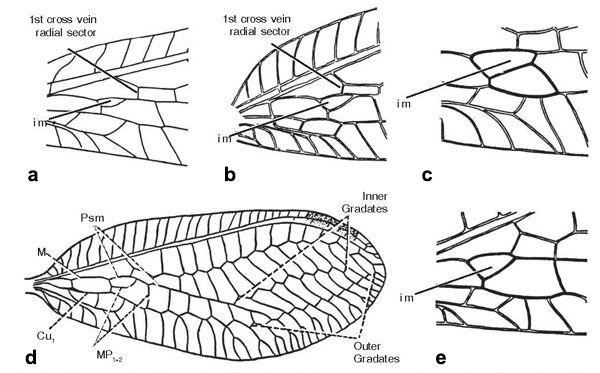
Key to Genera of Green Lacewings of Florida
Adults
1. Flagellomeres 6–10 very broad, at most 1.1 times longer than broad; pretarsal claws simple; eyes large, greatest diameter nearly as much as interocular diameter; larvae associated with ants (Belanopterygini) .......................2
1'. Flagellomeres 6–10 narrower, at least 1.25, usually more than 1.5, times longer than broad; pretarsal claws often with subbasal tooth; eyes usually smaller, greatest diameter much less than interocular diameter; larvae not associated with ants.......................3
2. Pronotum twice as broad as long, with 8 large dark brown spots; antennal flagellum black at base .......................Abachrysa Banks
(Abachrysa eureka Banks 1931, only species in the genus, is found in the southeastern USA [AL, AR, FL, GA, MS, TX]
2'. Pronotum about 1.5 times as broad as long, lacking spots but with broad dark red or purplish marginal or submarginal band; antennal flagellum completely pale brown .......................Nacarina Návas
(Only one species in Florida, Nacarina robusta (Banks) 1905; known from the Panhandle and Highlands County.)
3. Hind wing pterostigma with dark brown spot (Figure 3); antenna longer than forewing (Leucochrysini); forewing intramedian cell (im) quadrangular or foot of basal sectoral cross vein of forewing about same level as origin of radial sector; larvae are trash-carriers ....................... 4
3'. Hind wing pterostigma without dark brown spot; antenna usually shorter than forewing; forewing intramedian cell (im) triangular, basal sectoral cross vein distal to origin of radial sector; larvae not trash-carriers (except Ceraeochrysa).......................5
4. Forewing intramedian cell (im) quadrangular (Figure 5c).......................Leucochrysa McLachlan
(Only one Florida species, Leucochrysa insularis (Walker) 1853; widespread in eastern United States and the Caribbean.)
4'. Forewing intramedian cell (im) triangular (Figure 5e).......................Nodita Návas
(There are three species in Florida: Nodita callota Banks 1915, Nodita floridana (Banks) 1897, and Nodita pavida (Hagen) 1861.)
5. Hind wing lacking inner gradate cross veins.......................Eremochrysa Banks
(There is one unconfirmed record from the Florida Panhandle of Eremochrysa punctinervis (McLachlan) 1869.)
5'. Hind wing with many inner gradate cross veins (Figure 5d).......................6
6. Forewing with first RS cross vein meeting vein MA distal to apex of intramedian cell (im) (Figure 5a); pronotum without red or orange marginal or submarginal bands (often yellow median band); antennal flagellum pale, gradate cross veins usually green; male sternites VIII and IX fused, apex with distinct lip....................... Chrysoperla Steinmann
(The four Florida species are Chrysoperla. externa (Hagen) 1861, Chrysoperla harrisii (Fitch) 1855, Chrysoperla plorabunda (Fitch)1855, and Chrysoperla rufilabris (Burmeister) 1839. All species are probably widespread in Florida because they are used for biological control.)
6'. Forewing with first RS cross vein meeting vein MA before apex of intramedian cell (im) (Figure 5b); pronotum usually with red or orange marginal or submarginal bands; antennal flagellum sometimes dark brown, gradate cross veins often dark brown; male sternites VIII and IX not fused, without distinct lip .......................7
7. Forewing with radial gradates oblique; pronotum with four reddish spots (Figure 1)....................... Plesiochrysa Adams
(The widespread Neotropical species, Plesiochrysa brasiliensis (Schneider), has been reported for Florida.)
7'. Forewing with gradates straight; pronotum marked differently....................... 8
8. Gena unmarked; antennal scape with one or more red, brown, or black lines or else colored with homogeneous reddish pigment ....................... Ceraeochrysa Adams
(Most speciose genus in the New World with six species in Florida: Ceraeochrysa cincta (Schneider) 1851, Ceraeochrysa claveri (Návas), Ceraeochrysa cubana (Hagen) 1861, Ceraeochrysa lineaticornis (Fitch) 1855, Ceraeochrysa smithi (Návas), and Ceraeochrysa valida (Banks) 1895. Both the adults and trash-carrying larvae have been keyed by Tauber et al. (2000).)
8'. Gena marked with red or antennal scape completely unmarked....................... 9
9. Face marked with red or pink transverse lines between the anterior tentorial pits and below the antennal fossae (Figure 2); eyes relatively large; wings narrow .......................Chrysopodes Návas
(Chrysopodes collaris (Schneider) 1851 is found in south and central Florida.)
9'. Face without such lines or if lines present, colored dark brown; eyes small; wings broad.......................Chrysopa Leach
(Penny et al. [2000] have keyed the US species including the Florida species Chrysopa incompleta Banks, Chrysopa nigricornis Burmeister 1839, Chrysopa oculata Say, Chrysopa quadripunctata Burmeister 1839, and Chrysopa slossonae Banks.)
Key to Genera of Green Lacewings of Florida
Larvae (unknown: Abachrysa; Nacarina; Chrysopodes; Plesiochrysa)
1. Non–trash carriers; abdomen long and slender, longer than head and thorax together, without hooked setae; thorax with scoli no longer than wide .......................2
1. Trash-carriers; abdomen short and broad (not much longer than head and thorax together), with many hooked setae (Figure 4); thorax with scoli at least twice as long as wide, bearing elongate setae.......................3
2. Head capsule with two prominent, black, elongated spots.......................Chrysoperla
(Larvae are described by Tauber (1974).)
2'. Head capsule with three or four black or reddish spots.......................Chrysopa
3. Prothoracic scolus over five times longer than wide, extending beyond head (third instar) (Figure 4)....................... Leucochrysa; Nodita
(Notes on larvae by Muma (1959).)
3'. Prothoracic scolus less than four times longer than wide, not extending forward beyond head....................... 4
4. Hooked setae on abdomen very long; scolus short, setae not fan shaped; thorax with purplish-red color pattern.......................Eremochrysa
(Larva described by Smith (1922, 1926).)
4'. Hooked setae on abdomen shorter, inconspicous; scolus longer with setae arranged fan-like.......................Ceraeochrysa
Selected References
Bickley WE, MacLeod EG. 1956. "A synopsis of the Nearctic Chrysopidae with a key to the genera (Neuroptera)." Proceedings of the Entomological Society of Washington 58: 177-202.
Brooks SJ, Barnard PC. 1990. "The green lacewings of the world: a generic review (Neuroptera: Chrysopidae)." Bulletin British Museum of Natural History (Entomology) 59: 117-286.
Canard M, Semeria Y, New TR. 1984. Biology of Chrysopidae. Series Entomologica. Junk Publishers. Dordrecht, the Netherlands. 294 pp.
Muma, MH. 1959. "Chrysopidae associated with citrus in Florida." Florida Entomologist 42: 21-29.
Penny ND, Adams PA, Stange LA. 1997. "Species catalog of the Neuroptera, Megaloptera, and Raphidioptera of America north of Mexico." Proceedings of the California Academy of Sciences 50: 39-114.
Penny ND, Tauber CA, De Leon T. 2000. "A new species of Chrysopa from western North America with a key to North American species (Neuroptera: Chrysopidae)." Annals of the Entomological Society of America 93: 776-784.
Smith R. 1922. "The biology of the Chrysopidae." Cornell University Agricultural Experiment Station Memoir 58: 1287-1372, figures 154-163.
Smith R. 1926. "The life history and habits of Eremochrysa punctinervis McLach. (Neuroptera)." Bulletin of the Brooklyn Entomological Society 21: 48-52.
Tauber CA. 1974. "Systematics of North American chrysopid larvae; Chrysopa carnea group (Neuroptera)." Canadian Entomologist 106: 1133-1153.
Tauber CA, De Leon T, Penny ND, Tauber MJ. 2000. "The genus Ceraeochrysa (Neuroptera: Chrysopidae) of America north of Mexico: larvae, adults, and comparative biology." Annals of the Entomological Society of America 93: 1195-1221.